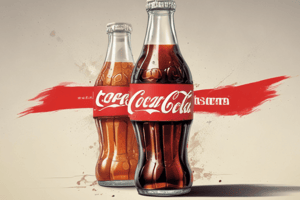Podcast
Questions and Answers
What does the TOWS Matrix analyze?
What does the TOWS Matrix analyze?
- The interaction of internal and external factors (correct)
- Only weaknesses and threats
- Corporate social responsibility
- Only strengths and opportunities
SWOT analysis is used to identify only internal factors of an organization.
SWOT analysis is used to identify only internal factors of an organization.
False (B)
Name one opportunity identified in a basic example of SWOT analysis.
Name one opportunity identified in a basic example of SWOT analysis.
Weak competitors
Coca-Cola can leverage its strong brand recognition and global distribution network to expand into __________ markets with growing demand for healthier and low-calorie beverages.
Coca-Cola can leverage its strong brand recognition and global distribution network to expand into __________ markets with growing demand for healthier and low-calorie beverages.
Match the following components of SWOT analysis with their examples:
Match the following components of SWOT analysis with their examples:
What is one recommended action for Coca-Cola based on the TOWS analysis regarding its weaknesses and opportunities?
What is one recommended action for Coca-Cola based on the TOWS analysis regarding its weaknesses and opportunities?
Value chain analysis focuses solely on external activities of a firm.
Value chain analysis focuses solely on external activities of a firm.
What are the two approaches to perform value chain analysis?
What are the two approaches to perform value chain analysis?
In the VRIO framework, if a resource can be duplicated by competitors, it is not considered _____.
In the VRIO framework, if a resource can be duplicated by competitors, it is not considered _____.
Match the following terms with their correct definitions:
Match the following terms with their correct definitions:
Flashcards are hidden until you start studying
Study Notes
Coca-Cola TOWS Analysis
- Weaknesses/Opportunities (WO): Diversification into healthier, low-calorie beverages aligns with rising health-conscious consumer trends.
- Weaknesses/Threats (WT): Adjustments to product lines and addressing controversies are essential to protect brand image amid shifting consumer preferences.
Value Chain Analysis (VCA)
- VCA identifies primary and support activities to enhance product value while reducing costs or increasing differentiation.
- It focuses on internal activities transforming inputs into outputs.
Cost Advantage
- Organizations seeking a cost advantage analyze cost drivers to understand competitive positioning.
Differentiation Advantage
- Firms using differentiation focus on creating superior products or services to stand out in the market.
VRIO Framework
- Valuable: Resources must enable exploitation of opportunities or defense against threats to be considered valuable.
- Rare: Unique resources can only be accessed by limited companies, enhancing competitive advantage.
- Costly to Imitate: Resources that are expensive for competitors to replicate hold significant value.
- Organized to Capture Value: Companies need organizational structures to leverage resources effectively.
SWOT Analysis
- SWOT analyzes internal strengths, weaknesses, external opportunities, and threats.
- Example Strengths: Localized products, skilled workforce, strong market position, CSR effectiveness.
- Example Weaknesses: High employee turnover, financial burdens, bureaucratic culture, low R&D investment.
TOWS Matrix
- The TOWS Matrix organizes SO (Strengths/Opportunities), WO (Weaknesses/Opportunities), ST (Strengths/Threats), and WT (Weaknesses/Threats).
- SO Strategy: Utilize strong brand and distribution for growth in healthy beverage markets.
- ST Strategy: Innovate packaging and distribution for e-commerce and direct sales advantages.
Corporate Culture
- Defined by beliefs, values, and practices, it creates a guiding identity and motivates employees.
- A strong corporate culture enhances employee retention and productivity.
Organizational Structure
- Illustrates member relationships and defines task execution, resource usage, and employee relations.
- Effective structure promotes information flow, control systems, and command chains.
Types of Organizational Structures
- Simple Structure: A basic organizational form with minimal hierarchy.
- Functional Structure: Division based on specialized functions.
- Multi-divisional Structure: Organizes by various products or geographical locations.
Business Resources
- Strategic assets, both tangible (land, machinery) and intangible (patents, trademarks), vital for competitive advantage.
- Resources must be difficult to imitate and have no direct substitutes to be deemed strategic.
Internal Environment Analysis
- Focuses on internal strategic factors revealing strengths and weaknesses.
- Identifies ways to exploit external opportunities and mitigate threats.
Studying That Suits You
Use AI to generate personalized quizzes and flashcards to suit your learning preferences.





